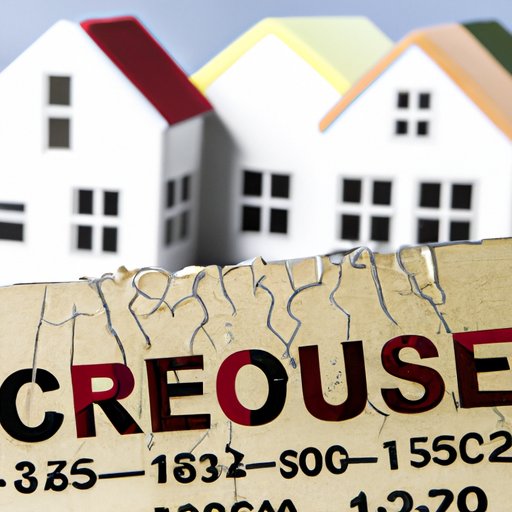Introduction
Foreclosure is a legal process in which a homeowner unable to pay off their mortgage debt is evicted from their home. It is a complex process with many steps, and can be overwhelming for homeowners who find themselves in such a situation. Understanding what is involved in a foreclosure is essential for anyone facing this difficult situation.
Exploring the Foreclosure Process: Step-by-Step Guide
To better understand how a foreclosure works, it is important to look at each step of the process. Here is a step-by-step guide of what is involved in a foreclosure:
What is Involved in a Foreclosure?
The first step in the foreclosure process is when the lender sends out a notice of default, which is a formal notice that the borrower has failed to make payments on the mortgage loan. If the borrower does not take action to remedy the situation within the time frame specified in the notice, the lender can then proceed with the foreclosure process.
Once the foreclosure process begins, the lender can repossess the property and sell it in order to recoup the unpaid debt. The proceeds of the sale are used to pay off the remaining balance owed on the loan. Any money left over is returned to the borrower.
How Long Does a Foreclosure Take?
The length of the foreclosure process varies depending on the state and the lender. Generally, the process can take anywhere from a few months to a year or more. It is important to keep in mind that the longer it takes for the foreclosure process to be completed, the more money the borrower will owe in late fees and other costs associated with the foreclosure.
Understanding the Foreclosure Timeline
It is also important to understand the timeline of the foreclosure process. There are three distinct stages of the foreclosure process: pre-foreclosure, foreclosure sale date, and post-foreclosure.
Pre-Foreclosure Period
The pre-foreclosure period is the time between when the borrower receives the notice of default and the actual foreclosure sale date. During this time, the borrower may be able to avoid foreclosure by catching up on payments, refinancing, or negotiating a loan modification with the lender.
Foreclosure Sale Date
The foreclosure sale date is the date that the lender repossesses the property and attempts to sell it in order to recover the money owed on the loan. At this point, the borrower no longer has any ownership rights to the property.
Post-Foreclosure Period
The post-foreclosure period is the time after the foreclosure sale date. During this time, the lender will attempt to collect any remaining balance owed on the loan. The borrower may also face additional fees and penalties during this period.
What to Expect When You’re Facing Foreclosure
When faced with the prospect of foreclosure, it is important to understand what to expect. Here are some of the most common steps in the foreclosure process:
Notices of Default and Foreclosure
The first step in the foreclosure process is when the lender sends out a notice of default, which is a formal notice that the borrower has failed to make payments on the mortgage loan. The borrower then has a set amount of time to catch up on payments before the foreclosure process can begin.
Loss Mitigation Options
In some cases, the lender may offer loss mitigation options, such as refinancing or loan modification, in order to help the borrower keep their home. These options can help the borrower avoid foreclosure and save their home.
How to Avoid Foreclosure and Save Your Home
If you are facing foreclosure, there are several options available to help you avoid losing your home. Here are some of the most common options:
Refinancing
Refinancing is when a borrower takes out a new loan to pay off the existing loan. This can help reduce the monthly payment and interest rate, making it easier to keep up with the payments and avoid foreclosure.
Loan Modification
A loan modification is when the lender agrees to modify the terms of the loan, such as reducing the interest rate or extending the repayment period. This can help reduce the monthly payment and make it easier to keep up with the payments and avoid foreclosure.
Short Sale
A short sale is when the lender agrees to accept less than the full amount owed on the loan. This allows the borrower to sell the property and pay off the loan without going through foreclosure.

The Consequences of a Foreclosure on Your Credit Score
It is important to understand the consequences of a foreclosure on your credit score. A foreclosure can have a significant negative impact on your credit score and make it difficult to obtain financing in the future.
Impact on Credit Score
A foreclosure can have a severe negative impact on your credit score. Depending on your credit history prior to the foreclosure, your credit score could drop by as much as 200 points or more. This can make it very difficult to obtain financing in the future.
Rebuilding Credit After Foreclosure
Although it may take some time, it is possible to rebuild your credit after a foreclosure. It is important to focus on paying bills on time and keeping balances low on credit cards. Over time, these efforts can help improve your credit score.
Conclusion
Foreclosure is a difficult process to go through, but understanding the process and what to expect can help make it easier. Knowing the timeline of the process and exploring potential options to avoid foreclosure can help you make the best decisions for your situation.
(Note: Is this article not meeting your expectations? Do you have knowledge or insights to share? Unlock new opportunities and expand your reach by joining our authors team. Click Registration to join us and share your expertise with our readers.)
